#PHOT303
Explore tagged Tumblr posts
Photo

PHOT303 - Mileage May Vary - From Film to Digital
COVID-19 has initiated a lockdown for our nation, with many businesses closing for this time and many being held under house arrest. This also means that shooting film at the moment is not possible, as I cannot afford to send over multiple medium format rolls to be developed and scanned, with the addition of lab scans not being wanted for this project. This is turn means that I have to shoot digitally for the foreseeable future. I personally do not have a massive problem with it, but I would prefer to use the Mamiya 7ii which I have that now lives in my camera bag until June.
With no surprises, I am using my old faithful Canon 5D and the 50mm F1.8 STM which has served me so well for many many years. Despite the 5D’s age, it keeps on clunking over and creating really nice images. The 50mm F1.8 STM might be the cheapest prime that Canon offer, but it is still a stellar piece of glass when one is on a budget. It uses the same optical design as previous iterations, but uses some newer coatings to reduce chromatic abberations and flaring.
Shooting has been extremely limited, due to being stuck in a village in Wiltshire with no way to explore further locations. The lockdown has severely limited where I can shoot and what I can shoot. There are only so many pre-2009 cars in a small village, yet there is another portion to the north that is easy to walk to and possible to explore. This will happen in due time.

It is hard to re-imagine what this project is, and what it is to become. It is still the documentation of cars that escaped the VSS, but it is now narrowed down into a singular location. I also have to get used to shooting in a digital format, of which I haven’t used for a project since this time last year. I am having to work around using a camera that isn’t analogue, a different aspect ratio and resolution. In contrast, I do feel right at home with the 5D as it is the camera that I use for my professional work, and the camera that I have used for the better part of 4 years. I am still sticking to shooting more of the encompassing area, instead of zooming into the details of the cars, as I feel that the spaces around the vehicles gives more context to the photograph as more of a field study of the economical aspects to car ownership. Above, is a Toyota Prius and an MG ZR sitting proudly on somebodies driveway. They’re quite a juxtaposing mix, as the Prius is a car synonymous with environmentally friendly inclined motorists, and the ZR more of a boy racer demographic. Yet, they are both parked on a driveway of a nicely presented bungalow, with a pristine garden where an elderly gentleman resides.

I also like to document the areas where vehicles have been, but aren’t currently there. With this, there is a hauntological aspect to the images, as a spectre of the vehicles is around in the form of the tyre tracks left in the dirt, but they aren’t there. I also like the bungalows in this area, as there is a New Topgraphics aspect to the design of them. There is an interesting mix of newer houses, with an older house just top the left of centre with the chimneys showing.

The editing process is also rather different when it comes to a digital raw file, as there is so much information on the image that can be recovered and changed. With digital files, I like them to be a flat as possible to emulate the ‘film’ look. For this, I reduce the contrast to a little as possible, and reduce the highlights to have a larger dynamic range. I always find digital images to be incredibly contrasty when compared to an analogue photograph. It also makes the image rather washed out and pushes the details up slightly. I find a lot of large format images also have this quality to them, with the contrast being fairly low and the details extremely high. Not to say that digital images can compete with large format, but still. This process shall continue throughout the lockdown period, continuing with the same editing style, camera and lens.
0 notes
Photo
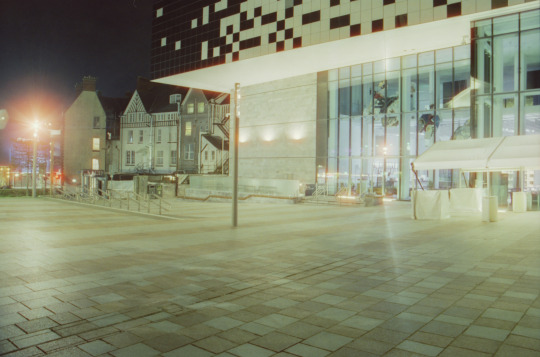
Getting Back into Creating
One thing that is always difficult is getting back into the swing of creating when there has been a hiatus. I have always found it hard to begin again, even if said hiatus isn’t as long as it is perceived. This goes for the short break from ending PHOT303 in the BA and starting 101 in the MA - which was only a few months.
Originally, I wanted to continue on with Mileage May Vary as my Postgraduate work, because it lead on from my previous work, as well as my written dissertation from third year. Yet, with some thinking, I didn’t feel right to continue that project within the academic setting once again and decided to keep that body of work personal. I then had to think about what I wanted to do for 101, and what could work for me in a higher level of education.
Previously mentioned is my next body of work: Epochal Territories. This is the continuation of PHOT201′s Alienated Spaces, which was the documentation of urban scenes with the hidden subtext of alienation felt with a Capitalist society. Epochal Territories is set to expand upon that, with more in-depth research, contextuality and photographic practice. In a sense, it is the follow on from that project and more so.
Moving on, this post is more about how I concluded to that decision and what I created to end up where I am now. At the start of the MA, I didn’t really know what road to take - do I continue on with a project, revisit something I am passionate about or make something totally new?

Shooting at night is something I thoroughly enjoy, but with film it is something I hadn’t properly undertaken with long exposures. Firstly, I decided to shoot with a Bronica ETRS which I later found out was not a camera designed for shooting at night and is incredibly idiosyncratic. It has to have a whole step by step procedure to create an exposure that is longer than 8 seconds which doesn’t make any sense, and makes me think why Bronica didn’t bother with a usual bulb mode. It goes like this:
1. On the lens, unscrew the switch where A and T are with a flathead screwdriver.
2. Now that the screw is loosened (not removed), Move the switch to T or time exposure which keeps the shutter open until you switch it back to A.
3. Compose and set the aperture and meter.
4. Fire the shutter for how long the exposure needs to be.
5. Once you have achieved your shutter speed length, cover the lens with either the lens cap or a dark card, and then switch it back to A.
6. Now you can advance the film and repeat.
So yes, it is a complete ordeal which I am not a particular fan of, not one bit. A lot of the frames were ruined because of trying to reapply the lens cap to flick the switch. The ETRS really wasn’t intended to be used for long exposures, but the camera can do exposures up to 8 seconds, which isn’t an issue until they get longer. To over come this, you can always switch it to multiple exposure mode and apply as many exposures as needed to complete the exposure.
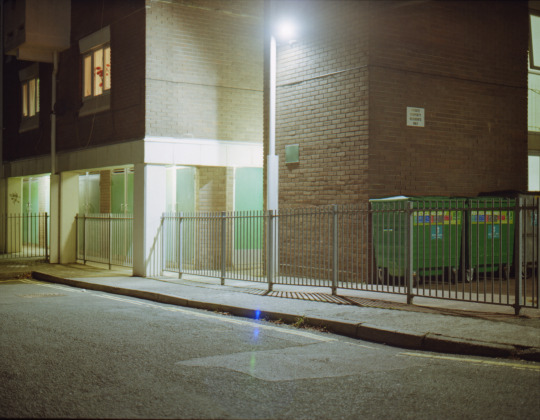

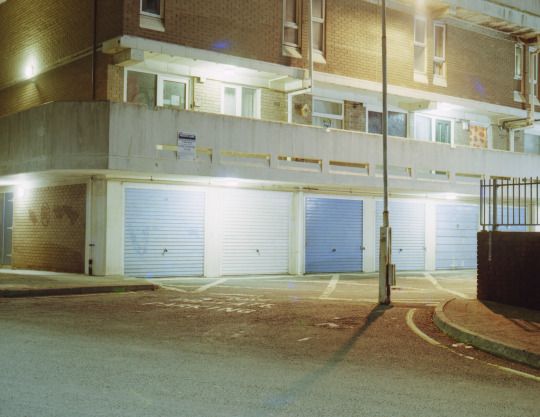
I also chose an odd film to shoot at night, which was Kodak Ektar 100. This film is famed for it’s saturation, sharpness and extremely fine grain - it is about as slide film-esque as a negative film can be. I have had a tumultuous relationship with Ektar in the past, as I haven’t been able to scan it how I would like it, and I always end up avoiding it like the plague. Yet somehow at night, it really shines. The saturation is a lot more subdued and becomes much more flat in terms of it’s tonality, yet still retaining it’s lush colours and sharpness.
There is also a mixture of projects happening from this role, as it was where I felt I was at the crossroads of projects, with a mixture of Mileage May Vary and what it is Epochal Territories. Eventually, I chose the latter because it is closer to what I am feeling within the zeitgeist, especially in the times on COVID-19. My own feelings of alienation are a lot more pronounced and prevalent today than they were when working on MMV, so it makes sense to go back to this body of work.

A number of days later, I chose to shoot a camera and film stock I am a lot more familiar with. The Canon EOS-1 is my go-to 35mm SLR because of it’s nature of being a professional grade SLR, and the ability to use the same lenses as my digital camera. I also chose to shoot Cinestill 800T, which is a staple for nighttime photography. 800T is just a rebranded and reworked version of Kodak Vision T, with the remjet layer removed so it can be developed at any C41 or easier at home, and this also creates some serious halation on the highlights, beaming out a red glow where the light it at it’s brightest. The EOS-1 is also a lot easier to use as it was made to be a jack of all trades for professional photographers in the early 1990′s.

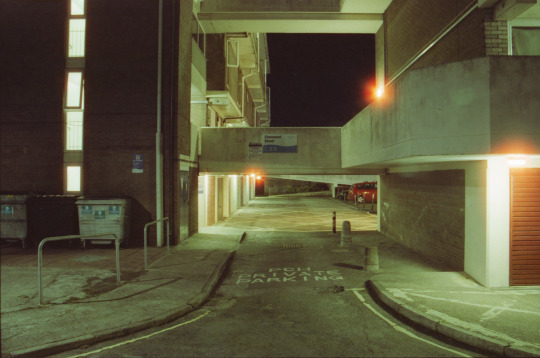
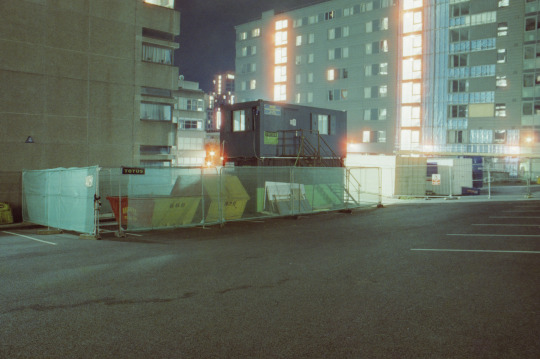
The EOS-1 was paired with a 28-135mm USM which is a good all-round lens that covers most useful focal lengths at apertures from F3.5 at 28mm and F5.6 at 135mm. The lens was stopped down to F8-11 with exposure times ranging from 4-15 seconds depending on the ambient light, with each exposure being metered with a Minolta Auto Meter III and the corresponding exposures being overexposed by a stop or two.
With the roll of Cinestill, I wanted to capture the desolation of the city at night which is unsettling compared to the usual hustle and bustle of the day, and especially pre-covid. The spaces are meant to be completely devoid of any persons, with the semiotic of being detracted from everyone else placed within the frame by the inherent desolate nature of the image. It was with this roll of film I decided this was the route I would like to take, because it feels a lot more relevant not only to our times, but also my life. My photographs would be direct documentations of our epoch, hence Epochal Territories.
This is what separates Alienated Spaces from Epochal Territories, is that the former was more aimed towards myself, where the latter is aimed towards myself but also our everyday life within supermodernity causing the alienation of which I feel.
Where does this leave me? Well, this means that I can keep a project do undertake within my own time, and one to work on within a more academic setting. This also means that I can explore the relation between the non-place, and the alienation that stems from our hypermodernity, in addition to explore more areas of Plymouth and it’s surrounding areas more thoroughly (depending on the lockdown regulations as of late 2020/early 2021). I plan on reading Francis Fukuyama’s The End of History and the Last Man, where Fukuyama states that our zeitgeist has got to a point where supermodernity has slowed down history with any lack of significance, and mankind has reached it’s endpoint and almost at our final form. This book was mentioned by Mark Fisher in his text Capitalist Realism, Fisher explains it is easier to imagine the end of time compared to an alternative to Capitalism. Fukuyama’s text should prove insightful and go towards the further understanding of how we live today, and why our epoch is particularly alienating - which shall be answered in time.
0 notes
Photo

PHOT303 - Mileage May Vary - COVID-19 Update
COVID-19: The Elephant in the room. The end of December saw a Virus start to sprea across Wuhan, China. In the West, we were simply peering into China and seeing what the situation was, and making sure that this wasn’t going to spread to anywhere else but that location. Public information posters started to litter public areas notifying people if they had been in Wuhan within the past 14 days, and the symptoms of Coronavirus.
A couple of months pass, and cases started to pop up within the U.K, and the rest of Europe. During that time, people weren’t that bothered and it was seen as nothing more than the flu, as infection and death numbers from Influenza outweighed what Coronavirus could do. Personally during that time, I was one of those people who wasn’t all too concerned about it, as I had been through the whole Swine Flu and Ebola debacle and assumed, that this was going to be same.

(March 2020, Colerne)
Then people started to pass away, and people still stuck to the assumption that it wasn’t as bad as the Flu and went on with their usual business. This proved to be a silly move, as it transpired that people could have COVID-19 and show no symptoms and basically act as a carrier, spreading the illness from person to person. As the deaths and infections rose, people still didn’t care all too much and went with their normal daily doings. Countries in Europe started nationwide lockdowns to keep their population indoors and fight the spread, whilst we kept on going as normal. This would prove detrimental, especially when in mid March we were told to stay indoors, and people fled to beauty spots like beaches, national parks and the country side. People ignoring that advice could have been the straw the broke the Camel’s back, as more and more people were bundled together and potentially, could have spread the infection even more than before, as droves of people flooded into Snowdonia and Weston Super-Mare. This in turn created a nationwide lockdown of our very own, with the Government pleaded all to stay indoors, and only go outside for obtained key supplies and one form of exercise per day. Despite this, people still ignore the Government’s plan to stop, or slow the spread of COVID-19.
The pandemic has caused some issues when it comes to this project, and our third year as a whole. Firstly, I am not able to get the photographs as I would like to get, as I am only allowed outside once a day, and I am staying in a village in Wiltshire with a very limited selection of vehicles to photograph, with the inability to drive anywhere due to the lockdown. Another issue is shooting film, as nowhere local can develop film, and I would have to rely on postal orders. Whilst I can do this, I do not have anything to scan the film with, and I cannot afford to have a lab scan it for the amount that I would like to shoot. In addition to this, I do not want to have a lab scan my film, as the quality wouldn’t be consistent with the rest of my work. This is rather annoying, as I have the Mamiya 7ii booked for the entirety of Easter with the 65mm F4. I am shooting film along side my 5D (which I thankfully brought with me when we escaped).

(March 2020, Plymouth)
The other issues mainly centre around the university itself, and the decision to move everything to a digital submission, and our summer show/Free Range being totally up in the air. With a digital submission, this would mean that physical media would be made totally redundant, making photobooks, zines and prints useless within this climate. These would most likely take the form of a digital platform to show the work, with the addition of digital photobooks and zines. Annoyingly the deadlines are staying the same, which I feel is a shortsighted and downright stupid decision. A pandemic has spread across the world, with many in financial difficulty or simply not being able to access materials which is paramount to creating work. Some students don’t have a good enough internet connection for digital work, and some students would need to access parts of the university to do their work, like 3D Crafts and glass blowing. With photography, it isn’t too bad of a transition, but it can still cause massive disruptions with some of our cohort having to totally change their work. Thankfully, we do have a blanket E.C (Extenuating Circumstances) across the whole of the college with extra time given to third year students. This is a good thing, as we will all have to adjust to fully digitally submitted modules for this semester. I do not think that we would be able to adjust to this format, and be able to keep the same deadlines. Our deadlines have been extended to August 2020, which should be enough time to adapt our projects during this pandemic.
Now, we will have to wait to see how our modules will be adapted to fit this all new digital submissions. I would have thought that they would have to have a journal, or blog, such as this. There will probably be something like a digital exhibition space, seeing as our summer show and Free Range will most likely be postponed to a later date, with the addition of digital photobooks and or zines. For me, this is a viable option as this blog shall continue through PHOT303 regardless of the deliverables - yet this will be the last time it shall be used. Now is time to stand by to standby for any updates with our redacted deliverables.
0 notes
Photo

PHOT303 - Mileage May Vary - 14/3/2020
This day was meant to be a trip to the Exeter Phoenix with Louise, looking at some art work and some moving image, yet a spectre loomed over the day, and the future. I decided to bring along the Mamiya 7ii on my travels, and load it up with a fresh pro pack of Kodak Portra 160 (before the price went up!).
Just as I arrived at Exeter St Davids, I had a call from Louise explaining that she had to go home and self isolate. The Coronavirus (COVID-19) was beginning to become a concern to the nation. This had been bubbling for a while, and the news started to report cases of it in China in late 2019 and early 2020. It had made it’s way to the U.K, and confirmed cases were being reported. Currently (that being 27/3/2020) it has worsened and the whole country is in lockdown, which is in turn being enforced by the police services. Yet this whole situation deserves it own post explaining the changes due to this. Back to our normal broadcast.
Since the trip had been cancelled as soon as I arrived, I took t upon myself to meet up with my old friend, Thom, as he is an Exeter resident. He had never seen a 7ii in the wild, so he was in awe about the camera. I had a few hours to spare, and I thought that the singular roll of Portra would have lasted me all of that time. And yet, I shot it all within about 30 minutes of starting it.

Another Vauxhall Combo, parked on somebody’s driveway on Eldertree Gardens, which is next to St. Davids Hill. The hill coming up from St Davids station is long and steep, but it saves waiting around the station for 40 minutes for a 120 second train ride into Exeter Central. The hill is tiring, but it only takes a few minutes to walk and it is good exercise. I almost walked past this Combo, but I have always enjoyed the design of these houses, and they are oddly nostalgic looking to me. If that Vauxhall Combo was swapped with something a bit older, I would think that it would be hard to decipher when this photograph was taken. I decided to stop down the lens to around F8 this time around, to get more in focus and to increase the sharpness of the 80mm F4. And I do have to say, it just gets sharper the more it is stopped down. Even when these are scanned with my Canoscan 9000F Mkii (previously written about and despised), they’re amazingly crisp. I have also found a size of negative that the scanner seems to work well with. 35mm scans always looked really bad, but it seems that the bigger the negative, the better quality the scan. Everything I have shot with the 7ii has been scanned using the Canon at 2400dpi. This might be a high dpi to be using, but it also collects a lot of the detail that I would like to retain.

I met Thom in town, grabbed a strong black coffee and we walked around the roads around the quay. And to the surprise to me, there was a lot of scenes that worked so well for MMV, hence why the roll didn’t last all too long. Here, is a Fiat Panda and the legendary Fiat Coupe. Just like the Alfa Romeo GTV, Fiat’s do have some questionable quality control and electrical choices, yet they’re fantastic cars. The Coupe was a model Fiat made during the 1990′s, which is a rare sight in this day and age. They are somewhat of a modern classic with what seems to be a cult following, with the most popular model being a turbo five cylinder, propelling the Coupe to 62 mp/h in 6.3 seconds. And just like the Rolls-Royce in the previous shoot, the cars seem to juxtapose the setting, yet fit in quite nicely.

Just up the road from the Fiat’s was this rather odd Renault Megane sedan. These Megane’s are usually hatchbacks, so it is a rare sight to see them in their sedan layout. This is also the only shot to include cars older than the proposed 2009 Scrappage Scheme. The bright white Megane contrasts the overgrowth, as well as the grubby Fiat 500. i wanted the Megane to take centre stage in this photography as it’s an oddity which isn’t seen all too much, and with a quick database check, it’s possibly the cleanest 2003 Megane around, with only 83000 miles, and passing every MOT apart from a few with minor issues. It is nice to see this Renault, baring down on 20 years old standing the test of time.


The final two shots are of the same Ford KA parked outside Watergate, above the quay. The KA is also a design that has stood the test of time, with the KA’s design originating from the early 1990′s, and being introduced in 1996. It is hard to believe that this design is of a similar age to me, as it looks, even today, to be modern and contemporary. As I took the first photograph (top), Thom was towards the back looking towards the block of flats, with him saying: “oh dude this is the one”. With one shot left, I had a look and he was right! It is possibly my favourite image to date and perfectly sums up what I want to be doing with this project. It manages to document the ageing, banal and boring cars that litter our urban landscape, as well as the urban landscape itself. I also like the addition of Kodak Portra 160. Despite it being less versatile than it’s 400 counterpart, it is a lot cheaper and finer grained. I do like the film’s overall aesthetic and quality, and it seems to match well with the Mamiya’s lenses.
The advent of Coronavirus has put a spanner in the works in terms of image creation for MMV. This was the last roll that was shot before social distancing, self isolation and quarantine was a regular occurrence and a requirement. This could mean the shooting the Mamiya 7ii could be placed on the back burner, and shooting digitally could be the only way that this project can progress. This does seem to change how I shoot, and I fear I won’t be able to create the work that I want to be able to create. I will however be shooting the 7ii at the same time as the 5D, and getting it developed when I am able to get back to Plymouth. I am of course able to send film off to be developed and scanned via postal order, but I cannot afford this with the amount that I am shooting, seeing as it is around £15-£20 per roll in total. So I shall develop the rolls at my local lab, and scan them at home when I am able to get back home.
0 notes
Photo
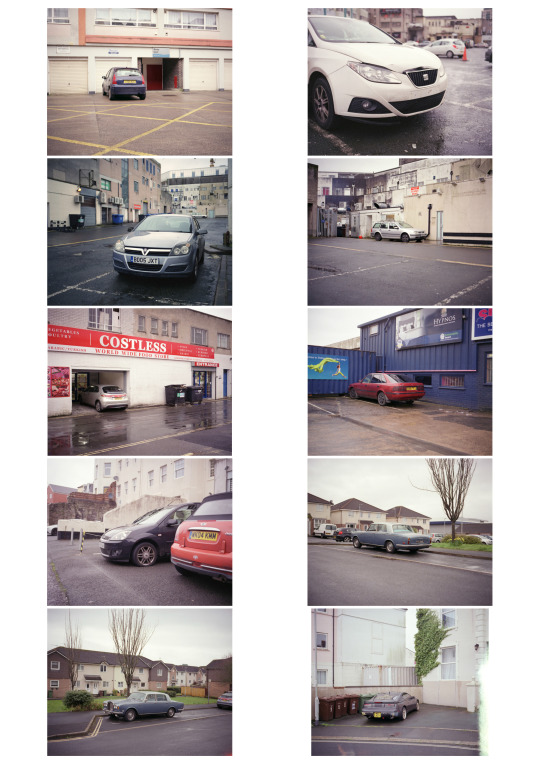
PHOT303 - Mileage Mary Vary - 4/3/2020
I decided to swap out the Mamiya 7ii that didn’t work, for one that finally did! But this shoot didn’t go without an issue. Now that I had a working 7ii to use, I was excited to see what I was going to create. I decided to take it upon myself, to head back to using expired film to see that I could create. I have had very good success with expired Fujifilm stocks, and loaded up the 7ii with a roll of Fujifilm Superia 400, which expired in 2012. With this in mind, I over exposed the film by a stop by metering the film at 200 iso.

A Citroen C3 is parked at Morley Court. This is one of my favourite locations in Plymouth, as it feels so removed from Plymouth as a whole. It is a housing estate that is plonked in the centre of town, towards the end which is lower on the social/economic scale. I find it interesting that the location reflects on the conditions of the vehicles, as the lower the perceived class of the area, the condition of the vehicles worsen and the age of the vehicles also increase. This would mean that the individuals on lower incomes, can’t necessarily afford to have a newer vehicle and keep it in a better condition. I find it interesting to shoot in a variety of locations that seem to justify this by documenting what lies within the specific areas.
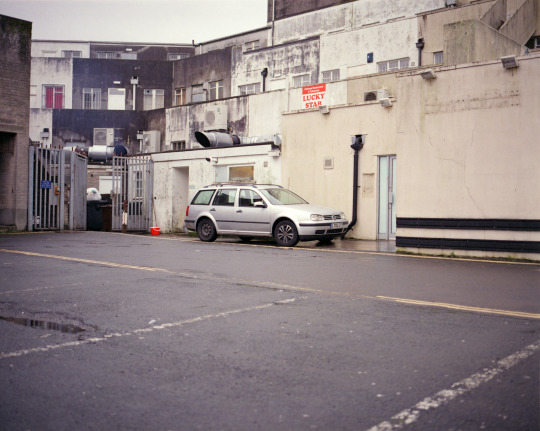
A Volkswagen Golf Estate MK4 is parked in the car park behind Lucky Star, which is on Raleigh Street. The whole area is an expansive network of grubby post-war buildings, which here are the backs of business and extractor fans. The particular Golf isn’t in the best of conditions, with missing wheel trims and an array of dents and scratches. I fell that this car manages to reflect on the nature of the surroundings. The 7ii also manages to pick up the small details, like the exhaust tube on a building to the left, forcing out a plume of blue smoke.
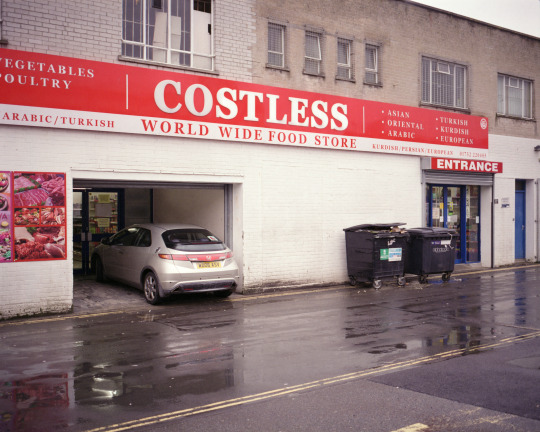
The eight generation Honda Civic was a far cry from previous iterations in terms of it’s design. Just like the MK3 Golf, it was a more more rotund compared to it’s earlier flavours. This immediately caught my eye, as the Civic managed to match the facade of Costless. I also did like the ‘Cost Less’ managed match the theory of the Vehicle Scrappage Scheme being used to boost the economy after the 2008 Financial Crisis. Again, the Mamiya manages to pick up so much detail within the scene, when the items within the shop itself. I also enjoy how I compose my work with this camera, as it does put me back into the mindset of capturing the scene, rather than just the vehicle being the main focus. Speaking of which, I didn’t even stop down past F4, which is wide open for the 80mm. F4 is a fairly wide aperture for 6x7, and can create some shallow depth of field once you get closer to the subject. yet as these distances, there is some subtle fall off between the foreground and the cars that are now in focus.
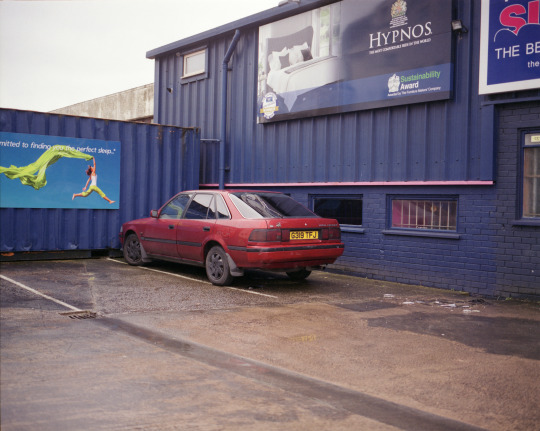
Something which used to be a familiar sight, a Toyota Carina. I remember seeing rather a lot of these when I was little, and they have disappeared from out road since, and most likely due to the Vehicle Scappage Scheme. It is hard to believe that this particular model was registered back in 1989, so it had been on our roads for over 30 years now. Yet, it manages to look rather well for it’s age, only really with some discolouration and some dodgy panel angles. This particular vehicle was parked outside a carpet shop in a side road that runs parallel to Ebrington Street. It was only later that it was pointed out the ‘Sustainability Award’ on the billboard above the Carina, which also coincides with the Scrappage Scheme. Just after I took this photograph and took the image of the Fiesta and the Mini, the potential owner came out of the building and was wandering his car and looking at me, almost inspecting. I assume he wasn’t all too pleased I was photographing his ancient Toyota.
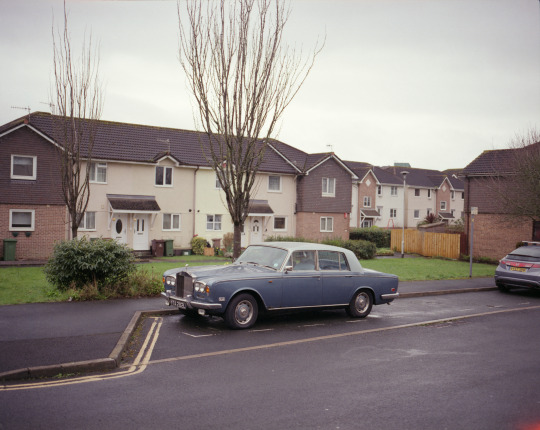
A bloody Rolls-Royce Silver Shadow! I have seen this whilst walking near White Friars Lane, which runs adjacent to Beaumont Road. The old Roller juxtaposes the newly built housing, yet almost manages to mix well into the scene. The Silver Shadow exudes high class motoring, with leather, walnut and chrome spilling from all areas. Whilst they were pricey purchases when they were new, they have depreciated so much that they’re almost affordable now...until it goes wrong or needs a service and then the bills start to add up, and the purchase of the vehicle becomes the cheapest part. There is also a noticeable, yet small amount of light leak on the lower right portion of the frame. During the shoot, I noticed that winding on the film didn’t feel entirely right. It felt as if it wasn’t winding as it should, and as I wound the roll to finish it, and opened up the back, I noticed that the roll wasn’t as tight as it should be, and was noticeably fatter. I suspect that this was due to the age of the film, and a potential comparability issue between the film and the spool that was left in the 7ii when I collected it. This can happen with 120 film and sometimes there is an issue, despite this being the first time I had encountered the issue.
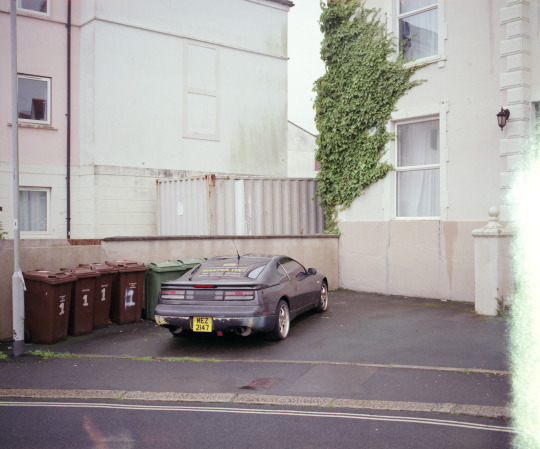
Here you can see the extent of the damage from the loose roll, with some light leak and fogging onto the last frame. This is the most affected image, but it is recoverable just by cropping. This photograph of a Nissan 300ZX advertising a window tinting company immediately looks like something Tom Westbury would have taken, with similar tones and composition. I am not sure how the 7ii does it, but the vertical distortion is always well corrected and always seems to by straight. It makes me wonder that all those times I wrote about Westbury’s work and the post production, it could have very well just been done in camera. I suspect that as 6x7 is such a large negative, it is easier to get the vertical lines straight as they should. The 300ZX is also an interesting vehicle, as it is a part of Nissan’s Z line of sports cars which also seemed to take a design change compared to the previous models. They are also a rare vehicle in this day and age, with many being molested by tuners or for the very few, kept nicely. I have never personally seen this car move, and this would be because it is currently SORN. With a quick check with the Government database, this is a 1990 model and was first registered in 2004, making this a grey import from Japan. This particular ZX is in a state of disrepair, with faded paint and a variety of dents and scratches. It also features some exhausts that the Channel Tunnel would be jealous of and some hideously dated alloys.
At last! A successful roll of film that resulted in some shots that I am proud of. It has been a long time since I had shot something and felt good about it. For a long time, I had become estranged from what I had shooting, and in all honesty, didn’t entirely enjoy what I was shooting for PHOT301. It wasn’t what I had envisaged and I am only just starting to get on my feet in regards to how I am making my work. And this is mainly down to using the Mamiya 7ii, as it puts me in the mindset of creating work and in it’s outcome, something that I really enjoy. The experience of using the Mamiya is great, and I cannon wait to see what else I can create this medium format beast. Yet I would like to be able to use different lenses, like the 65mm F4.
0 notes
Photo

PHOT303 - Mileage May Vary - 2/3/2020
I decided to step up my camera selection, and used a camera that I have always wanted to use. The Mamiya 7ii is, for me, the perfect film camera. The 6x7 images are massive, with an insane resolution for a camera that is not that much bigger than your average DSLR. The lenses, whilst at a maximum aperture of F4, are incredibly sharp and offer a nice range of focal lengths. The rangefinder is nice and bright, as easy to focus...but I’ll get onto that soon.
The 7ii was loaded up with a roll of Kodak Ektar 100, and we were ready to go! Oh hang not just yet as it was given to me without a working battery - never mind I shall go and buy one (the first image was in Russell’s shop just after I put a new battery in it). Once the 7ii was up and running, it went like a dream. The Ektar was also an interesting choice, as it is a contrast compared to the Portra range of films which is usually attributed with this camera. Portra is usually rather low contrast and washed out, when Ektar is saturated and full of popping colour. Although Ektar is a finely grained, sharp and nails colour negative film which is actually quite versatile.

There was one glaring issue with this particular Mamiya: the rangefinder wasn’t calibrated properly so when the patch in the viewfinder said it was in focus, it wasn’t. Rangefinders work in a different way to SLRs, in that you aren’t looking through the lens to take to photograph. The lens operations a cam, which then is in turn connected to a series of mirrors that form a patch in the viewfinder, which is mean to be calibrated to the lenses focus. The lovely moist road of this photograph is in focus, but the Royal Mail Vauxhall Combo is just enough out of focus to be noticeable. This was a reoccurring theme spanning the majority of the roll, only becoming slightly better when you get closer to the subject.

And again. The road - mainly the double yellows - are in focus, perfectly fine. Yet the Ford Fiesta is ever so more out of focus, compared to the Combo. This was highly irritating as I was enjoying using the 7ii for the first time, and thought that I had some good shots. It was making me shoot in such a way that reminded me of PHOT201′s Alienated Spaces, as I was tending to look more into the spaces, rather than the details of the cars themselves, although I did do that a few times.

Perhaps the most annoyingly missed shot was of this Alfa Romeo GTV. The GTV is quite a rare car now, as Alfa Romeo’s have a reputation from being amazing to drive, yet annoying to live with. Their reliability and build quality is, questionable as they mostly suffer from terrible electrical systems and metal so thin it may as well be one sided. The side of the skip is perfectly in focus, yet the GTV is again, ever so slightly out of the plane of focus just enough to be noticeable. Borrowing equipment from the ERC is always a risky one, as they aren’t always kept in the best of conditions. Despite this, it doesn’t take much to get their equipment serviced every one in a while to make sure that they are working to the best of their abilities. The Mamiya 7ii is an amazing piece of equipment which I just with I could afford, but it is sad when I get it and it doesn’t work as it should...and that I have to purchase a battery from a friend to get it to work.
This was my first toe tipping into the waters of 6x7 photography. Despite the rather annoying issue of it not focusing properly, it was great. The 7ii is such an enjoyable camera to use and it is hard to be angry at it. The negatives are massive for a relatively small camera, and they’re beautifully sharp to boot! The only real bug bear I have with it, is it’s extremely sensitive shutter button. It also have to dual purpose as a metering button, so when it is half pressed, it shows a meter reading of the scene, with then a full press taking the photo. But there isn’t much distinction from metering to photo taking. Apart from the shutter button, there are no issues to speak of. I would like to be able to use their other lenses to see what all this fuss is about with their sharpness. I would also like to use a different film stock - surprise surprise. Whilst I do like Ektar, it is too ‘punchy’ for the subdued approach to me work. I shall also swap out this particular 7ii for one that is hopefully working well.
0 notes
Photo
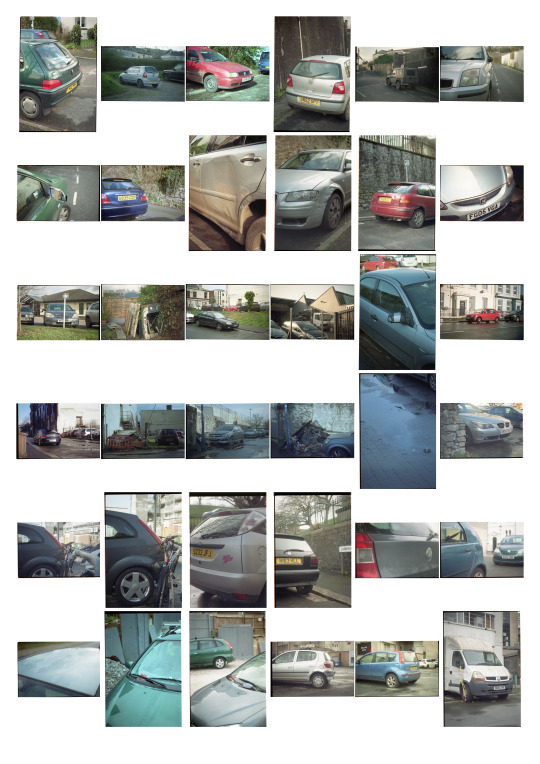
PHOT303 - Mileage Mary Vary - 4-23/2/2020
35mm cameras are certainly a favourite of mine, as they are compact, and cheaper than a new full frame DSLR. Medium format is my desired platform, but that doesn’t mean that 135 can’t be used from time to time.
This roll of Kodak Pro Image 100 started off in Totnes, with a camera that has been laying around for years...and it’s another Yashica. This time, its an TL Electro-X. This is an M42 mount 35mm SLR, with a simple stop down meter which has the coveted title of being the first camera with miniature lamps to let the user know that the exposure information. I thought I was use it for one more time before I eventually sell it, as it just sits around in a box never really being used, as my Pentax Spotmatic F is my main and only M42 mount camera. So this was a mix of a camera test, and another shoot for MMV. Although, I do not plan on using any 135 images for MMV, as they don’t hold the resolution and aesthetic for the project as well as the 120 format.
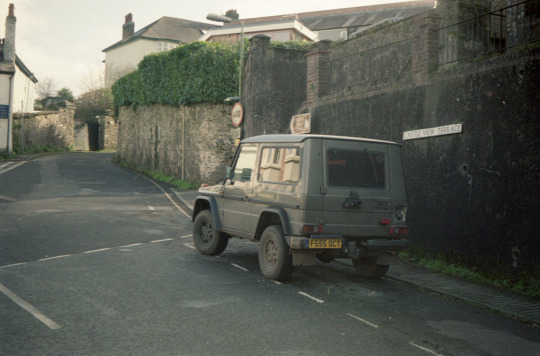
I firstly had one of my favourite lenses mounted to the Yashica: the Industar 50-2. This is a 50mm pancake lens, with a maximum aperture of F3.5 which was made in the Soviet Union. The lens is...optically different compared to newer optics and offers some certain nuances. Not to say that it’s rubbish, but it creates some interesting bokeh and is surprisingly sharp for what it is. They’re decently cheap to buy and millions of them were made, so they’re plentiful. Above, is a Mercedes 300 GD, which is one of many versions of Mercedes’ G series of vehicles. They’re robust and well made four wheel drive vehicles that can tackle harsh terrain, and even the hills of Totnes as it stands. The 50mm focal length is my go to focal length, as it can do close ups, and landscapes rather well for that I am doing. It is also easy for my to compose the shot, as it seem to see in this focal length in mind which usually makes it difficult to use anything other than 50mm.
The film is also quite nice. I have had several rolls for a while, and shot a few and not had them developed, so this served as the first one I ever had done. And fair to say, I rather like it. Pro Image 100 serves as a middle ground between the cheap as chips Kodak Colour Plus 200 and the expensive Kodak Portra range. It still manages to keep that Kodak golden glow but it doesn’t separate itself too much from their other offerings.

This is just around the corner from my home, where a number of 50ft Leylandiis where eventually fell after a year or two of discussion. Here are some Land Rover parts that lay in someones driveway and have eventually been taken over by the undergrowth. There is something inherently interesting about vehicles, and vehicle parts that get left on their own, and nature reclaiming it back to itself. I guess it is because it marks the end of that vehicles life, and it’s potential usefulness - although this isn’t always the case as they can always be reclaimed back to use and be restored with enough time and money.
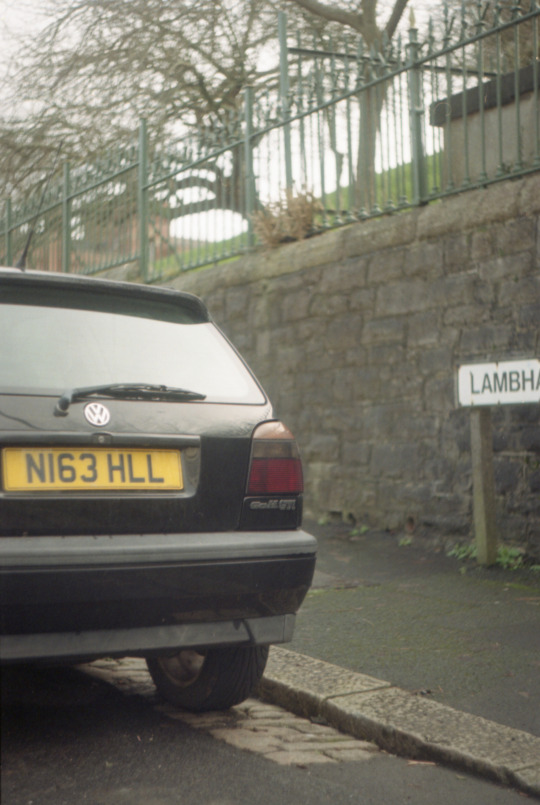
I didn’t finish the roll in Totnes, and it was eventually finished back in Plymouth with the addition of a lens change...but to another Soviet offering. I switched to the Helios 44-2, which is a highly regarded copy of the Carl Zeiss Biotar 58mm F2. The Biotar is one of many optical designs set out by Zeiss, with the Helios becoming a copy after the Soviet’s invaded Germany during the Second World War. Again, millions of Helios’ were made and they’re plentiful and cheap, yet they’re steadily on the increase as people are starting to realise that vintage glass is unique. The Helios is no acceptation, as it can create even wilder bokeh when the stars manage to align. Wide open at F2, it is often soft and ethereal, with no real sharpness until one stops down to F4. Above is a Volkswagen Golf GTI, but the often undesirable MK3. The first two GTIs were regarded as hot hatches, yet the MK3 was a lot larger and cumbersome compared to previous generations. Just like the 300 GD, not a great deal of nice examples exist, so it is nice to see that some are still kicking around, 20-30 years after their release.
Sadly, 35mm film just isn’t the format for this project. It doesn’t match up to the resolution that 120 offers, as well as the visual aesthetic that the larger negatives bring along with it. I personally see no advantage to use 135 when 120 is far superior in terms of resolution, aesthetic and creative limitation. Each photograph costs a lot more, and there is a lot less of them, so one has to be able to selectively choose what makes the cut, instead of having some leeway of what can make the cut.
0 notes
Photo

PHOT303 - Mileage Mary Vary - 13/2/2020
Medium format is such a great way of image making - it manages to mix large negatives with portability. I am able to step away from the sometimes limiting resolution of 135, but have the ability to use a camera that isn’t all to different in terms of weight and size.
I have in my possession, one of Aaron’s cameras. He very kindly let my borrow his first ever medium format camera: the Yashica EM. The Yashica is a 6x6 format 120 TLR camera, featuring their famed Yashinon 75mm F3.5 optics, found in many of their TLRs including the Yashica-Mat 124G. I have always had an issue with TLRs, as you aren’t viewing directly through the same lens the image is coming from, and waist level viewfinders can be awkward for me to use as everything is opposite and back to front. Having this camera with me would battle this feeling of awkwardness and potentially, make me enjoy square images again.
Me, Harriet and Aaron decided to go to Torpoint, mostly because me and Aaron wanted a pasty from Warrens, but all of the branches in Plymouth had shut down. I loaded up the EM with some partially old Kodak Portra 400, which expired in 2016. This isn’t massively expired, but I would soon find out that Kodak doesn’t keep all that well with their newer emulsions.

I have shot film that is a lot older that 2016 before, but there is something about the backing paper that Kodak uses that doesn’t seem to age all too well. Of course, this can be due to the conditions that the film has been left in, but three and a bit years of expiration isn’t usually something to worry about. As you can see from this photo of a Daewoo Matiz, there is some serious issues here. This is due to the backing paper sticking to the film and transferring its material. This can also transfer information from the paper including shot numbers and the film name. If it wasn’t for this expiration issue, I would have liked these images a lot more than I do now. This is certainly a game of Russian roulette when one is using expired films, yet I would have expected this from a film that was a decade or two out of date, rather than a few years. At least the lens of the Yashica has lived up to expectations.

A Vauxhall Agila (Suzuki Wagon R+ that has been rebadged) is parked new the waters edge. You can see the extent of the damaged film here, with the shot numbers and markers imprinted onto the emulsion. If I was going for an experimental approach, this would certainly be acceptable. Yet, it feels like I wasted a roll of film, and I could have had some keepers if the roll was a tad more fresh. But, these are the risks that are undertaken when expired film is used. Most of the time - in my experience - it has been totally fine with some slight colour shifts. I am not all too proud about this shoot, but serves as some experimentation and some water testing with TLRs and 6x6 images. And the answer may surprise you...
I still hate them slightly. Both of these aspects make the whole shooting experience very awkward for me, as I prefer to have the viewfinder up to my eye and not trying to force the photograph into a square. The waist level finder can be overcame with the addition of a prism finder, but the EM doesn’t support this and I can’t entirely afford a camera that does...currently. I feel like I am also trying to force myself to like 6x6 images too, and I can’t keep lying to myself, I really do hate it. There is a specific way to compose in that format, and I can’t get it to work for what I am doing, so I may just have to retire square format images from this project, and progress onto 6x7 instead. Expired film is also another thing to keep an eye out for, especially Kodak stocks. I spoke to Russell at Soperfect Images about it, and he has said to me that due to the backing paper they now use, they don’t keep as well as older stocks, or stocks from other manufacturers like Fujifilm.
I have learned to stay away from 6x6 TLRs, and expired Kodak films for now. The whole shoot wasn’t all too enjoyable, as I was using a camera that I didn’t massively enjoy, with the images coming out being next to ruined thanks to their manufacturing. Thankfully these are easy things to overcome, just by using a different camera and a different stock of film.
0 notes
Text

PHOT303 - Mileage May Vary - 16-21/1/2020
This roll started right before the end of PHOT301, with no time to complete it before the module finished. This wasn't an issue, as MMV hasn't changed and it will just pass through the submission and be the first set of images for the final-final major project piece. It also serves as a good platform from where MMV can go to, potentially acting as a stepping stone to how it will progress.
There is something about Cinestill 800T that just gets to me. It manages to render light so attractively and gives off a certain cinematic aesthetic - which is obvious - as it's motion picture film, modified to be processed in a lab. This shoot started on 16/1/2020, when me, Harriet and Aaron walked around Faraday Mill: a location I've wanted to shoot in before. It's incredibly still at night, with the odd gust of wind making some things rattle and a desolate reverbarance. It totally juxtaposes Faraday Mill during the day, with busy businesses and bustling car parks. The area is lit by lampposts and spotlights, which gleam upon the mise en scene.
The film was loaded into my Canon EOS-1 coupled with a 50mm F1.8 STM - which is now my go-to 35mm setup, as to me, it is an almost perfect version of my 5D for analogue shooting. Using this camera means that I am able to use all of my EOS lenses, like I can with my digital counterpart. The only real difference is (apart from being film), is that it has a single autofocus point (which is no issue as I have always used a single point in the centre and reframed each time) and that the body is poly-carbonate instead of magnesium. The autofocus is sometimes typically late 1980′s and will hunt around a bit, but for the most part it is fast and accurate.
On to the shoot. Faraday Mill, as previously mentioned, is a place that I have always been interested in shooting, but never really got around to actually utilising it. The whole area is a business park, with multiple tenants from mechanics to salons. At night, it has a certain desolate quiet which is inescapable. This theme of uncanny quietness was often disrupted by the final nine images on the roll, which were taken in Exeter in the very very early hours of the 21st January after the 301 submission. We all got to Exeter at around midnight of the 20th, and there were queues of people going into nightclubs, despite the freezing temperature.

The subjects have stayed the same for MMV over the transitory period - anything previous to being made in 2009 which has a certain aesthetic intrigue is fair game. This would mean that it must have some battle scars, weathering or be somewhat historical. This Vauxhall Rascal was one of the vehicles which was mentioned in one of the latter posts of PHOT301, when I didn’t have my camera with me to document it. Thankfully, the poor old Vauxhall doesn’t seem to move very far. For this, I wanted to incorporate more of the background, instead of solely focusing on the details of the vehicle for the entirety of the project. For me, it gives the vehicle more context, in addition to making it more lonely, in the sense that there is nothing really around it apart from the non-place that it resides.

I was finally able to photograph something of a scrap yard. Granted, it is across the road and at night, but I rather liked how the tree line, in addition to the fence causes a barrier between me and the yard. Stacks of old cars lie dormant, as the scrap handler will ultimately seal their fate.

Something that I need to really look at, is how I am composing my images and what I am including, From the feedback PHOT301, it seemed that there were two elements of image composition: close ups of detail and partial vehicle corner shots. This came across that I was unsure about what way to go with my images, as if there was some sort of typographical elements to my work, similar to Franck Bohbot’s Parked Cars or my photographs from PHOT104 Economy. Despite, this I would like to refine these two variations and have details of vehicle damage and full car shots including the environment surrounding it. An example of a mixture of these is the above image, showing an Audi A3 in the middle with a nasty dent in the boot lid. Here, I metered for the light shining on the boot lid, which is why the shadows are dark and the highlight from the background is blown out. Metering during night time is difficult, as it is inherently high contrast. The midtones are something I aim to meter for, yet metering for the shadows would allow for greater detail across the frame, but would need a tripod due to the longer exposure times. Midtone metering here was lacklustre, as the highest shutter speed was at around 1/60th.

When metering for the highlights, they become nicely exposed, with the midtones an shadows become muddy rather quickly, Here, I metered for the light coming from the street light reflecting on the bonnet of the Ford Focus, meaning the offside was underexposed. The shadows here are the worse effect areas, with the midtones managing to retain some detail. If I had metered for the shadows, I feel this would have been a stronger image. The sodium street lights also throw off the tungsten balanced film with an odd orange/green tint.

A Mercedes SLK is seen here parked with damage to the front bumper, nearside. You can see here how the sodium lights start to mess with the Cinestill, in addition to the slight fog causing some diffusion with the halation on the highlights. It was also around here where the weather started to cause an issue to my EOS-1...as the freezing temperatures managed to totally disable my viewfinder information, not allowing my to see what aperture, shutter speed or exposure value I was working with. Thankfully, the EOS-1 has an LCD screen on the top of the camera to display aperture and shutter speed, but not the value of the exposure. For the last few shots, the exposure was total guess work and it seemed to have worked well. Thankfully, when I got back into the car and it had warmed up, the display came back to life.
How does shooting at night improve, or add to my workflow? In short, it doesn’t. Whilst I enjoy shooting at night as it seems to feel more isolating, I do prefer to shoot during daylight purely due to the varying conditions that come with it. When the sun goes down, that’s it...its artificial light or you’re doing extra long exposures to see the stars. Cinestill is also something I love dearly with analogue photography, as it offers a unique and cinematic aspect to image making...yet it isn’t for this project. Just like the way black and white isn’t for this project, it just doesn’t fit the general aesthetic to this project, despite the fact that I love it. Black and white photography is great, but again it just isn’t the time. They all have their own respected uses, yet that time isn’t now. This does also juxtapose the inspiration of Vlad Tretiak’s images, as they are (for the most part) shot in the dark hours of the day. The addition of night photography also causes the exposure time to be longer, which can cause more logistical awkwardness with tripod use. Whilst this is necessary for such photography, I do prefer to simplify my gear and use as little equipment as possible, usually one camera and one lens.
For this, I would like to just have one camera per format (135 and 120). I would like to continue using the EOS-1 for 135, and either the Mamiya 7ii for 120 or the Yashica EM. The 7ii is more preferable due to the 6x7 image, as the square format, whilst has been used more often by myself, still find it awkward to use. WIth 6x7, it is slightly longer and retains a similar aspect ratio to 135.
For now, night photography will go on the back burner as it doesn’t entirely fit my aesthetic, and the body of work. Yet, I also have to whittle down how I am actually taking the images, and how they’re composed. I am always wresting the ways that I’m taking them - do I focus on the smaller details, or do I incorporate the entire scene?
1 note
·
View note
Photo
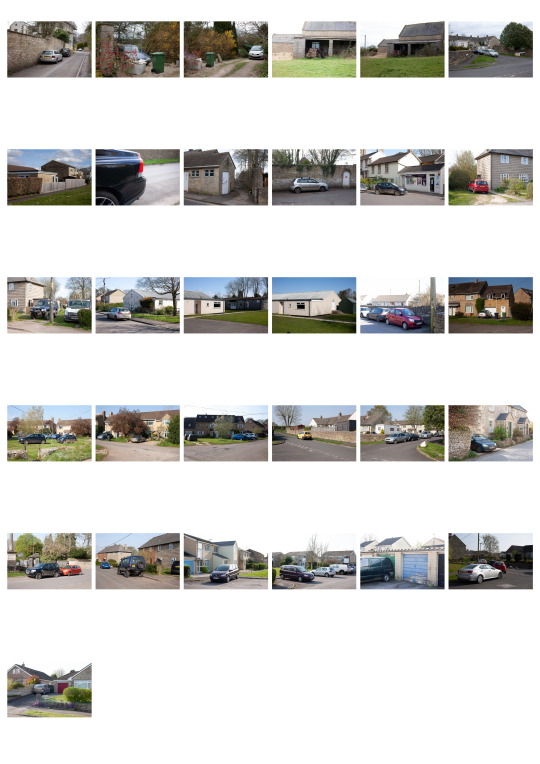
PHOT303 - Mileage May Vary - 5-9/4/2020
The adjustment to shooting digitally is well underway. I am only really used to this process when I am shooting for payed work, whether that is for the PCA:SU events or working for AYCH. It seems to strange to me that I am working on a personal project, and I can see those images instantly. Yet it is freeing to know that this is my only digital camera with only one lens to use, which is creatively limiting but with the knowledge of how to use that equipment.
The settings are pretty much on lockdown (pun intended), with the ISO being as low as possible (100) with an aperture of F8, with alternating shutter speeds depending on how the light is. At F8, most things are in focus with the distances I am working at, with the 50mm F1.8 STM being tack sharp before being effected by diffraction, which would start to set in with an extra stop at F11. The 5D also has a custom colour profile with the least amount of contrast to add to the faux-analogue look and feel, with the contrast and highlights being reduced in post production in LR.
All of the images are taken when I am on my daily allotted exercise around the village, which has a wide range of modern suburbia and quaint village life. A lot of Colerne is made up from fairly newly built houses from around the 1960′s, with the addition of the fairly typical Wiltshire houses built in the 1800′s. Both of these juxtapose each other, and look like their from different locations, but only are they really a stones throw away.

A Citroen ZX lies dormant in somebody’s driveway, surrounded by a bulk bag and a wheelie bin. This particular ZX has been sat for a while, and according to google earth it hasn’t moved all too much since 2013. This is most likely one of the 2041 recorded SORN ZXs according to howmanyleft.co.uk.
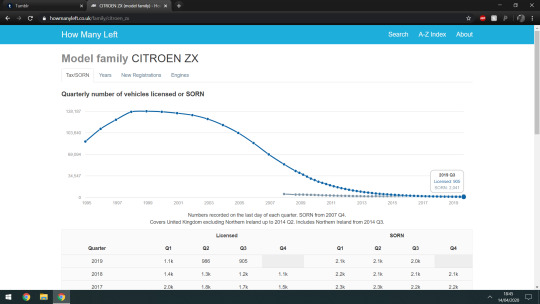
It seems a shame that a car which was seen extremely often, with at their peak in 1998 being 138,187 on the road, with the last quarter of 2019 seeing only 905 still driving our roads. Somehow almost double the amount of ZXs are SORN and off the road, just like this one. It might see the road again, but it could also be scrapped and then recycled.

A Toyota Celica and a Ford Fusion are parked next to a crossroads towards an entrance to Colerne. What piqued my interest was the black Celica which looks rather tattered and battered. This particular flavour of Celica was made from 1993-2000, also known as a T200. Something to note is that is has the wheels from the T230 which came a generation after this, made from 1999-2006. Without a registration plate, it is hard to define what model this is, as there were a few models with some being exclusive to North America and or Japan. This is most likely the AT200 verison, with the ST/ST Limited level trim. Places like these often give off an air of affluence and high standards, and seeing this Japanese sports car in a state of disrepair is almost like I am roaming around partially derelict estate. The surroundings however don’t reflect this, and contrast it with nicely presented houses and clean pathways.

5/4/2020
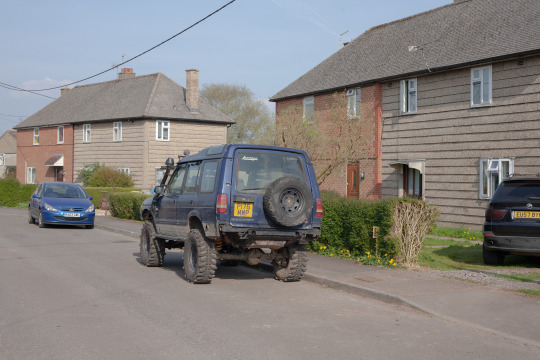
9/4/2020
I spotted this rather special Land Rover Discovery parked in a driveway, and I knew I had to capture it. The Discovery is usually a car reserved for the high flyers of the car world, with them normally lumbered with high prices and quality. Yet vehicles like that depreciate massively and become cheap to buy once they’re 10-20 years old. This is a Series 1 ‘Disco’, made between 1989-1998 with 2.0L petrol to 4.0L V8 engine options. This particular Disco has had a lift kit installed, with more aggressive tyres, bash bars and a winch. This means that this Disco has been converted to an offroader, which by the looks of its condition is used fairly regularly. Being in a fairly rural part of the country, there are plenty of areas that this can be utilised. This area isn’t as affluent as the rest of Colerne, with these houses looking like pre-fabricated post war or Council House offerings.

Thickwood is just over a mile away from Colerne, being a large estate made up with large house bristling with suburbia. The houses are nicely presenting with impeccable gardens and the cars sitting proudly on the driveway. They act as safe bubbles for the residents and are the key goal for many: to work hard, get a mortgage and own a house with disinfected counter tops and a nice car placed on the drive. These areas always remind me of OK Computer, as the themes of chasing a certain lifestyle and being a slave to capitalist ideals and expectations - which is a good link as OK Computer was recorded only a stones throw away from Colerne in St. Catherines Court. I also find it odd as I am acting as one of these suburbanites in a nice house and a clean car on the drive. Is this something I want? Is this expected of me? Do I need this? These suburban areas always remind me of Meeting People is Easy when No Surprises is shown on Sky News.

There is a certain cynicism within my work that reflects the lyrics of No Surprises. Whilst my work is documenting these cars that escaped the VSS and stood the test of time, it is also a commentary on our society and capitalistic tendencies to keep on spending, to own houses and cars all paid for by a job that we don’t like and slowly kills us. The elements of alienation from this lifestyle still lingers from previous projects as it is still felt by myself, and I think it will never leave me. It is interesting to me that I can manifest these feelings of alienation and estrangement in different ways, and it usually makes its way into what I do.

A Vauxhall Zafira found in its natural habitat of the suburban neighbourhood. For me, scenes like these heighten these alienated feelings, as these people have a house and a family. Vehicles like these warrant multiple children, as they were designed as MPVs (Multi Purpose Vehicles). These people have done what is potentially expected of them in life: they have worked hard enough to purchase a house, obtain a mortgage, work throughout the week and produce multiple children - Is that living? Do they enjoy it? Do they want this? These are hard to answer questions, and completely theoretical. But these are questions that I ask myself when in these settings. We live to certain expectations that is perceived within society and let technology rule what we do. The technology we use can be dangerous, with social media and mobile phones being constantly glued to our hands and our eyes. Some of OK Computer thematics is the rise in technology on the brink of the 21st century and it taking over our lives, become more and more robotic and it is becoming more real than ever. Who is serving who? Do we run this technology, or do we let it run is? These questions somehow run deep within a project that is inherently about the banal vehicles that escaped a scheme over a decade ago, yet they’re intrinsically linked to our society and its demons.
Whilst living in a suburban setting in the countryside is good to escape the encompassing pandemic, as well a offers some interesting photographic subjects, it also places some questions within me about how we live and what is expected of us. Do we really need to aspire to family living? Do I need to buy these things to make me happy? Why am I staring into this slab of glass with smooth animations and flashing lights? This could be the quarantine lockdown house arrest speaking, but I am questioning what life is and how we all live it. Despite the everyday mundanity going on, it manages to bring up questions to me that I can’t quite answer.
Despite being locked into a small village, there are a surprising amount of vehicles to photograph with some new ones appearing each day. I would have thought that shooting in such a small area once a day would severely limit what I could shoot, yet I am managing to capture much more than I expected. Even though I cannot shoot how I want to be shooting, I am enjoying the digital process more that I was anticipating. I can see the results near enough instantly and see any changes I make within that time. It is a lot cheaper, as I don’t spend anything to get my photographs - I just have to have space on my CF card and a charged battery.
0 notes
Photo

PHOT301 - Mileage May Vary - Interim Shoot 15/1/2020
A new year starts, and the work continues. However, by this time, shooting for PHOT301 had finished and the workflow mainly centred on making sure the blog is in check and tying up any loose ends. On a rainy Wednesday night, Aaron invited me and Harriet to check out Faraday Mill; an area that I have always wanted to explore but never got around to. I loaded up my Canon EOS-1 with some Cinestill 800T and got ready for a shoot...but the weather had other ideas.
And it rained all night. As the night was washed away, I chose to keep the EOS-1 safe for the time being and left it at home, but went out anyway to treat it as a recce of the location. I have driven past Faraday Mill for years and always wanted to see it at night. I am not sure how I haven’t been there, as I am fairly familar with wondering around Cattedown. This area was a goldmine of intriguing vehicles, cars broken for parts or left in disrepair. Thankfully, I had my phone to get some reference images. One of them that I captured was this little yellow Vauxhall Rascal.

The Vauxhall Rascal, which used to be called the Bedford Rascal, which is based on the Suzuki Super Carry is a Japanese ‘Kei’ truck or microvan. Kei cars in Japan are a category of automobile which classes them as lightweight street legal vehicles. They are usually regulated to 660cc engines, with other specific power outputs, weights and dimensions. However, the British derivative has a powerful 970cc four cylinder, which catapults the Rascal to a neck breaking 60mph. Despite their diminutive size, they were fairly handy small vans which can carry a surprising amount of weight for something about the same size as a pressure cooker.
These hold a special place in my memory, as it was one of the vehicle that my father had for work, oddly enough, when I was very young, possibly around 4 years old. I have a distinct memory of it being very cramped, noisy and dangerous, to the point that we almost tipped it over on a sharp corner, somewhere near Selsdon. Thankfully, this example hasn’t totally turned into a pile of rust and is still taxed and MOT’d! If anything, this project makes me thankful that some people still have relics of the past on the road. However, in reality they aren’t all too old, as the Rascal is only around 30 years old, and they’re diminishing in numbers and considered either defunct or a cult classic. It still amazes me that something that was only built 30, or even 10 years ago is now considered total junk and needs to be got rid of.

We did explore more of Faraday Mill, but I forgot to use my phone to get any more images on that day. This was a shame as there were a few cars left on a road which looked abandoned, but weren’t. I know this because I went back with my EOS-1 the next night when it was dry and shot the majority of the roll, and found some better subjects in return - this is the fateful roll of Cinestill 800T which I have mentioned in previous posts. This will be continued after PHOT301, and shall lead onto PHOT303, and of course will be scanned and uploaded once they’re ready, fairly soon.
Its certainly a shame that I didn’t have a camera with me at the time, but was also beneficial as I was able to scope out the area before partially shooting there - it was great to find some automotive relics, also. I am looking forward to seeing what is on that roll, and what will take the places of the final 12 or so shots. It felt a shame to not include these and not inform that I had returned with a camera to the area, but at a 24 hour later date.
0 notes
Photo

PHOT301 - Mileage May Vary Shoot #3 - 26/10/2019
Changing formats is always usually causes teething problems. Unlike the XPan, I have used this format before and I have since learned to love it. Shooting medium format is always an interesting experience, as the quality difference between 120 and 35mm is seismic. But, with 120, there are options from 4.5x6, all the way up to 6x17. Here, I am shooting the classic 6x6 format, which I have always felt odd about, even since shooting it since first year. A square photograph is hard to compose for me, as a lot of the typical modes of composition don’t necessarily don’t really apply. With this different format, you have to rely consider how to compose an image and how it’ll work on a square. With this, you have to look at central elements and equal lines. Although since shooting more and more 6x6, I have grown to love it and be able to use it.
I took my Mamiya 6 IV out for a shoot in the depths of night with Aaron. I loaded the 6 with some Cinestill 800T and set off, into the night. Cinestll 800T is one of mt favourite films, because it’s so different from the usual emulsions that we use day to day. Its an old Kodak motion picture film, that is white balanced for tungsten and has been modified to be developed in the normal colour C41 process. The rem jet layer has been removed so that it can be developed at normal photo labs* without the workers hating you when you ruin their processor. 800T also has a unique handling of highlights, as they create this incredible halation around anything that blows out the highlights - they become surrounded with a orangey red glow which really draw one in, and certainly tells the viewer that it was shot on Cinestill. Its also an 800 speed film, giving a lot of versatility with the exposure, as it can be shot all the way up to 3200 asa, which is two stops! 800T can also be shot in daylight at 500 asa, and with the addition of a warming filter if wanted. Here, I shot it at 800 asa and placed the 6 on my trusty Jessops Carbon tripod with a cable release. Annoyingly, My shutter speed ring moved during the first few exposures, so I wasn’t shooting in bulb as I suspected, rather it was on 1/5s. I noticed this when I was 1/3 way through the roll, which hurt slightly. The other issue was focusing, as shooting a rangefinder at night, with very little light is almost impossible when the camera is from the early 1950′s and the viewfinder looks like a peephole. Scale focusing was also difficult as I was wide open at F3.5 to get a shallow DOF, so the focus was sometimes missed and gathered some insane flare (look at shot 8).

Taken in the Courtenay Street Car Park- the same car park used in a few photos for PHOT102. This Citroen C3 intrigued me, as it was so dirty and had a few dents on it. To meter this shot, I used my newly acquired Canon EOS-1 with a 50mm F1.8 STM, with the camera set to 800 asa and mainly metering in the shadows. Thankfully, the EOS-1 has a very accurate meter an was able to create some good readings. This is also a good example of the halation on the highlights. It gives the image a really unique quality and I feel intrigues the viewer. The photograph has some nuances that creates some artistic differences, which is annoyingly used more too often to photograph American gas stations at night with a greasy rain-drenched ground. I would like to shoot this film more often, but at £13 a roll, it isn’t cost effective for 12 photographs. Its one of those film stocks that takes a special kind of occasion, and when the occasion arises, it can take some stellar images.

This is a more subtle example of 800T’s qualities, and shows off the 6′s optical qualities. The Zuiko optics create the ‘3D’ pop thing that many strive to achieve with classic lenses. Again, it was taken at F3.5 and at around 1/2s to a full second on bulb mode. The dirt and grime initially drew me to this Rover 75, as it tells me that this 16 year old English behemoth is well loved and used. The Rover 75 has always entertained me due to it’s massive rear number plate filling the boot lid. Why does it have such a large number plate, when the usual plates are regulated and standardised with all UK vehicles. This isn’t the only UK vehicle to have shaped plates, as its joined with the Jaguar X Type, S Type, XJS and Land Rover Discoveries. These plates just seem to comical, but obviously have some sort of reason, even it was down to the designers general aesthetic.

During the time of this shoot, I also came up with the name for this project: “Mileage May Vary”. I had contemplated and planned a list of names since the inception of this project during PHOT202. Other contenders from the list were: For What it’s Worth, Waste Not-Want Not and Crumple Zone. I felt that Mileage May Vary was rather apt, as the mileage of the prospective cars certainly varied due to its age and if it was scrapped, and harks back to automobile advertisements talking about their gas mileage. Even with this title, I am more proud of it, compared to PHOT202′s Spaces of Banality. To me, that project was so incredibly lacklustre that I am even embarrassed that I had even undertook it, as it was nothing that I wanted, and now I am doing something that wished I could have done during that time. MMV has certainly progressed since its inception earlier this year, and the seeds that were planted during PHOT104. From an aesthetically standpoint, I do enjoy being able to isolate the subject whilst keeping some of the surrounding areas still in frame. I don’t want to totally subtract the car from the street, as I still want it to be a part of the typical non place residing areas of these cars. Although, what the photograph is taken with will vary with formats. This project will include 135, as well as 120 format photographs. As for why, is purely an aesthetic choice and what I am feeling, and they both have pros and cons. 135 allows more photographs with portability, yet 120 offers up a massive upgrade in resolution but limits the amount of photographs per roll. I do not want to limit myself to any one format, and prefer to keep it open ended and mix formats up. I enjoy both formats and able to utilise them to the best of my ability. As well as 135, I plan to shoot more 120 in the future with my ageing Mamiya. I own three rolls of Cinestill 800T in 135, which I would like to use at some point with PHOT301, or PHOT303.
* - that being said, don’t trust all photo labs. This roll was developed at MyPhoto with a standard 30minute development, and they left the negatives covered in purple spots which can be seen with the expanded contact sheet. I won’t be using them again for Cinestill.
0 notes